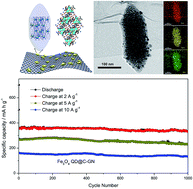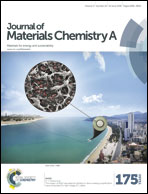In situ quantization of ferroferric oxide embedded in 3D microcarbon for ultrahigh performance sodium-ion batteries†
Abstract
Unlike conventional carbon coating strategies which only focus on the macrodimension to enhance electrical conductivity and alleviate volume variation for high-capacity metal oxide anode materials, a hierarchically raspberry-like microstructure embedded with three-dimensional carbon-coated Fe3O4 quantum dots is built for ultrafast rechargeable sodium ion batteries. Taking advantage of using metal organic frameworks (MOFs) as templates, it realizes an in situ quantization process in which Fe3O4 quantum dots are formed and uniformly embedded in microcarbon coating protection. Due to the short diffusion length and integrated hierarchical conductive network, the electrode combines supercapacitor-like rate performance (e.g., less than 6 minutes to full charge/discharge) and battery-like capacity (e.g., maintaining >90% of theoretical capacity). An interesting surface-induced process which imitates pseudocapacitive behaviors in supercapacitors is analyzed in detail. This proof-of-concept study and insightful understanding on sodium storage in this investigation may inherently solve the widely encountered problems existing in high-capacity metal oxide anode materials and point out new directions for the future development of ultrafast rechargeable sodium ion batteries.


 Please wait while we load your content...
Please wait while we load your content...